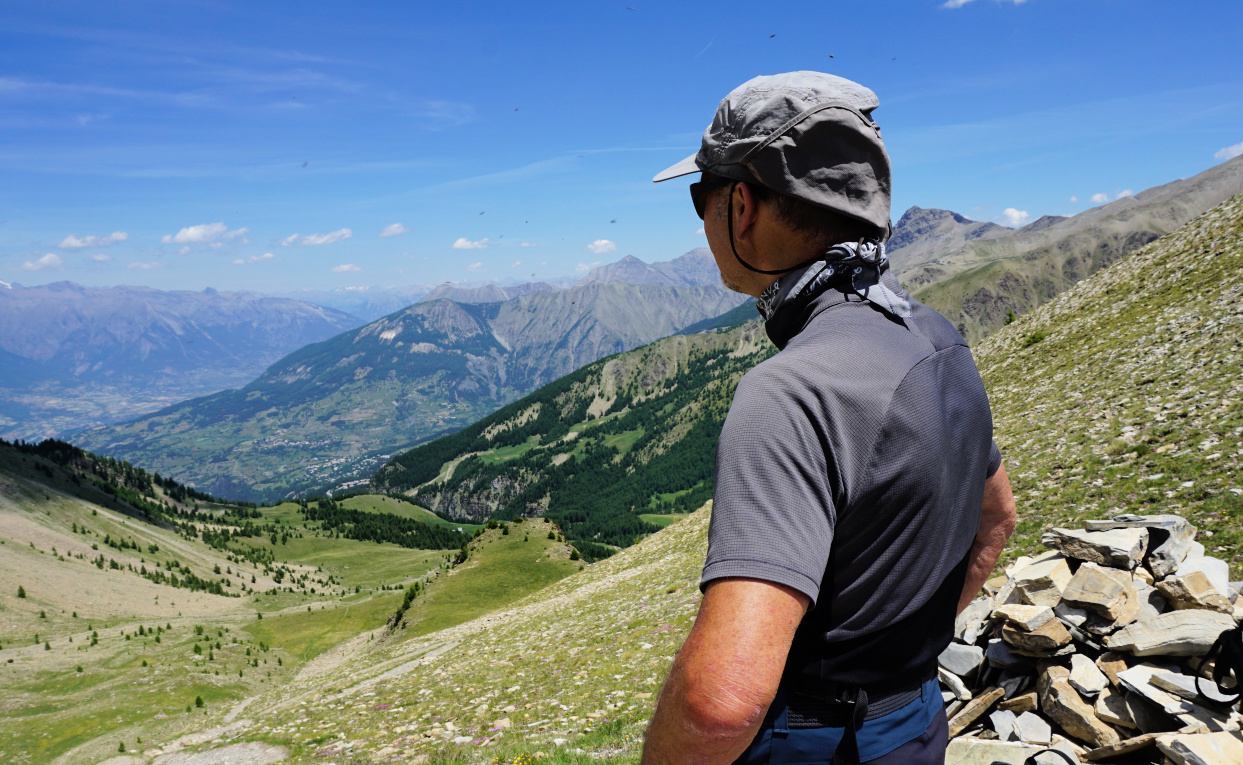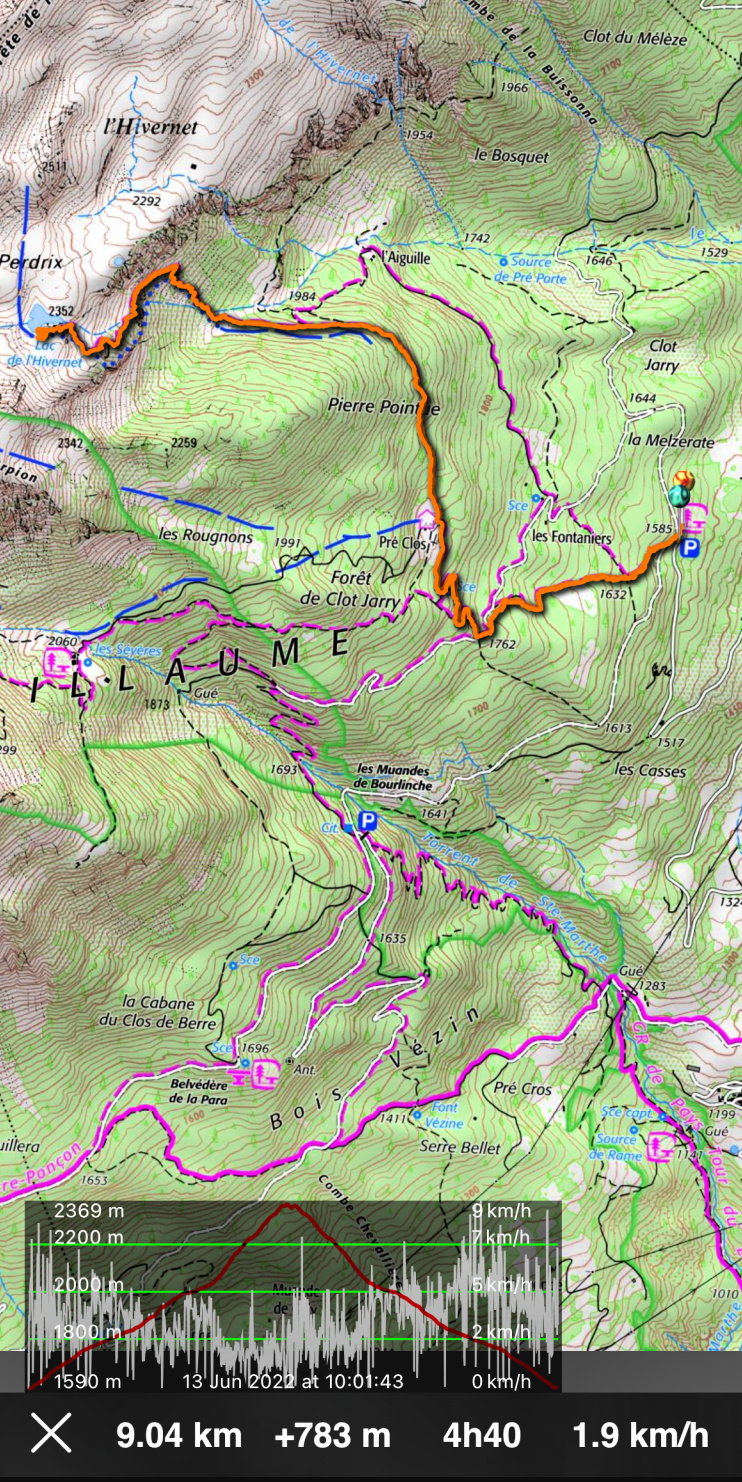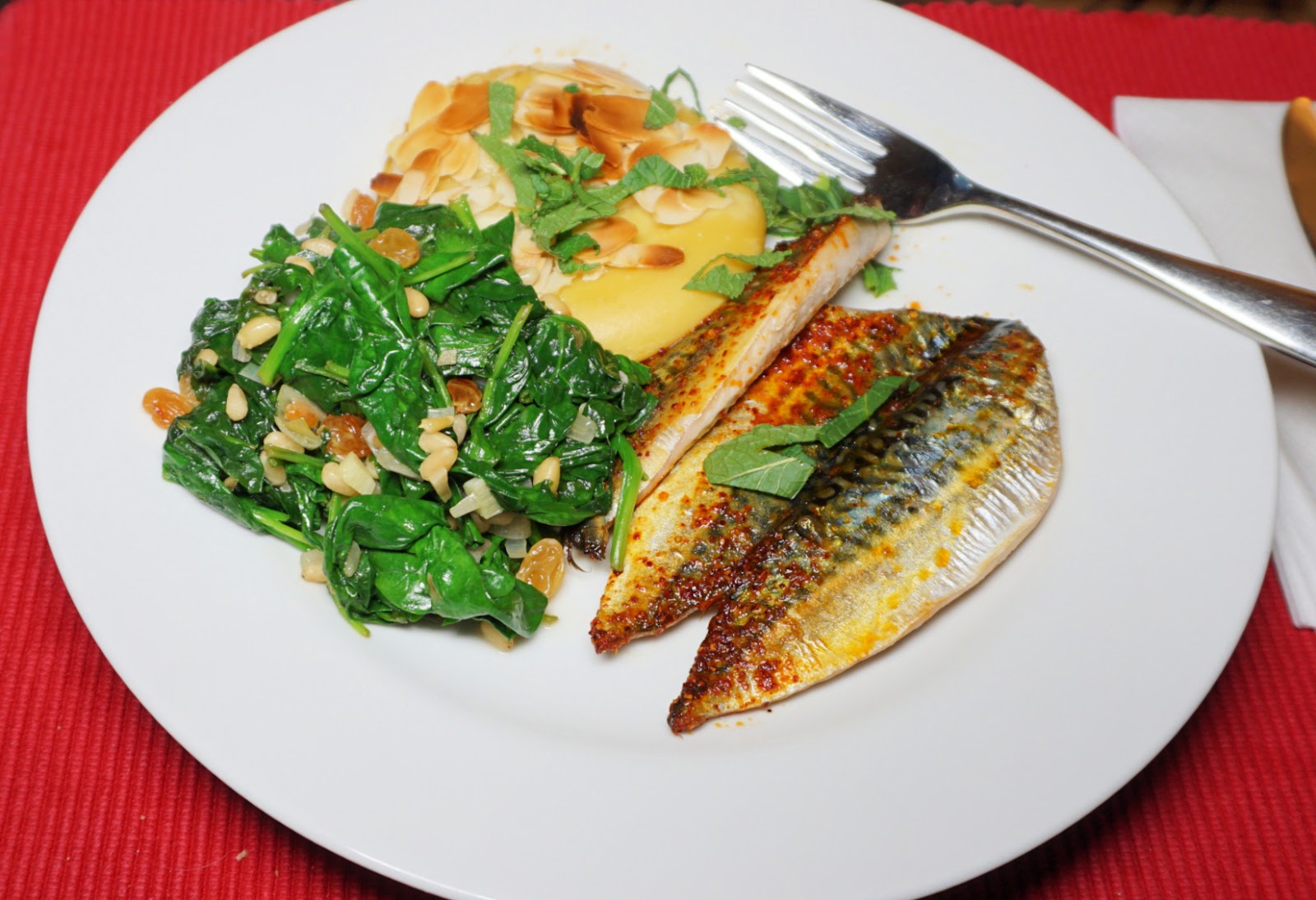It is possible to reach the high terrain above the resort of Les Orres via Lac de Ste Marguerite (2227 m). Having hiked to the lake a few years ago, we now wanted to climb a bit higher, to Col de l’Ane (2524 m). During the high summer season, when the chairlifts are running, you can take advantage of them. In Mid-June, however, the upper village (1800 m) was still deserted. The lift system does not reach Vallon de l’Eissalete where Lac de Ste-Marguerite is located, anyway.
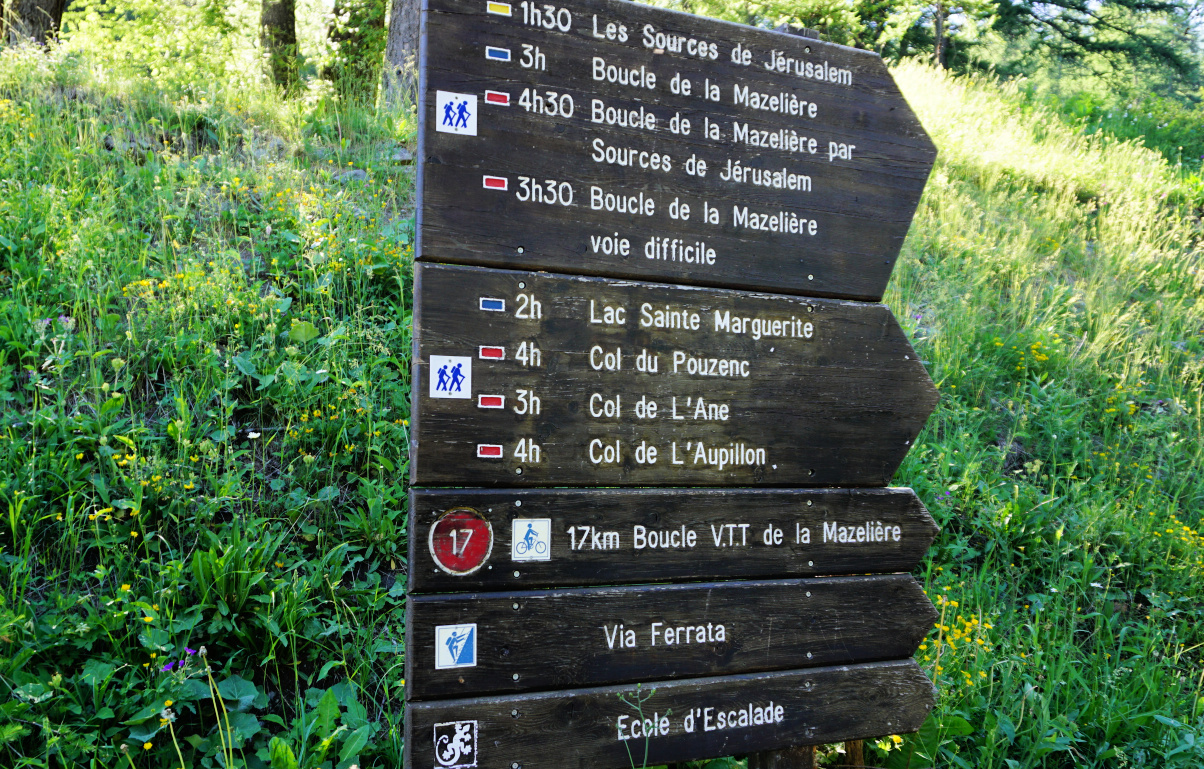 |
| Signpost at Bois Mean |
 |
| Lower Eissalete Valley |
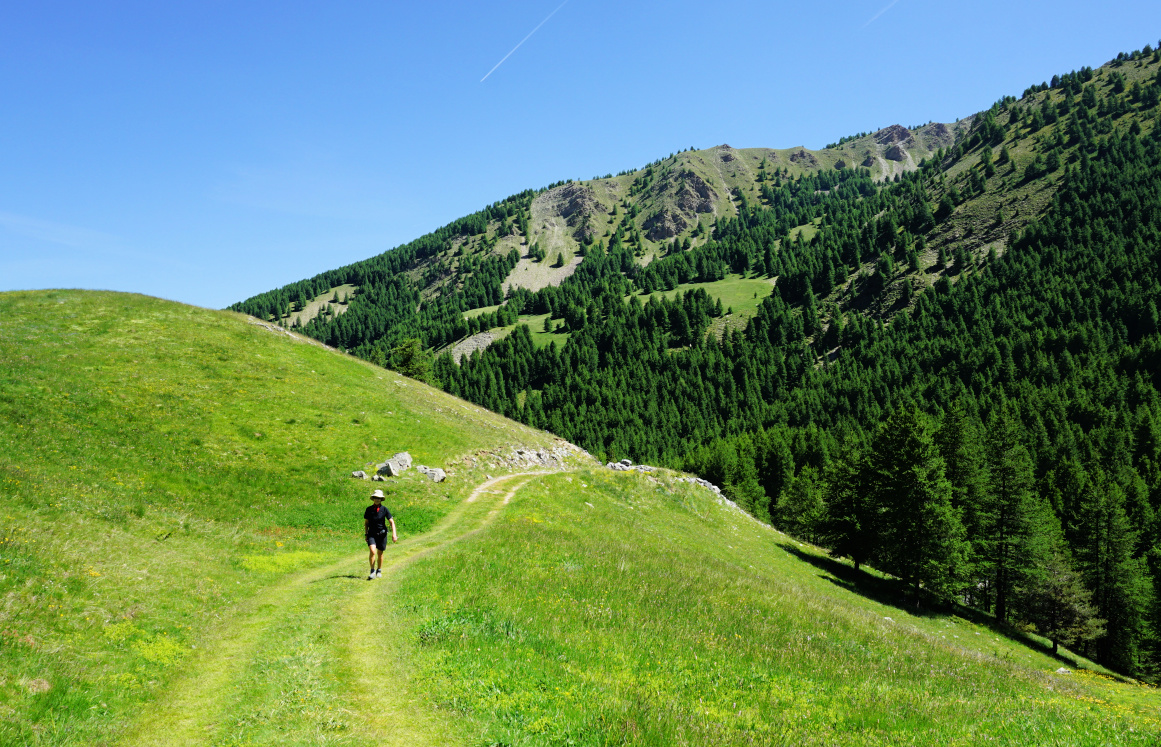 |
| Pra Paisset Orres |
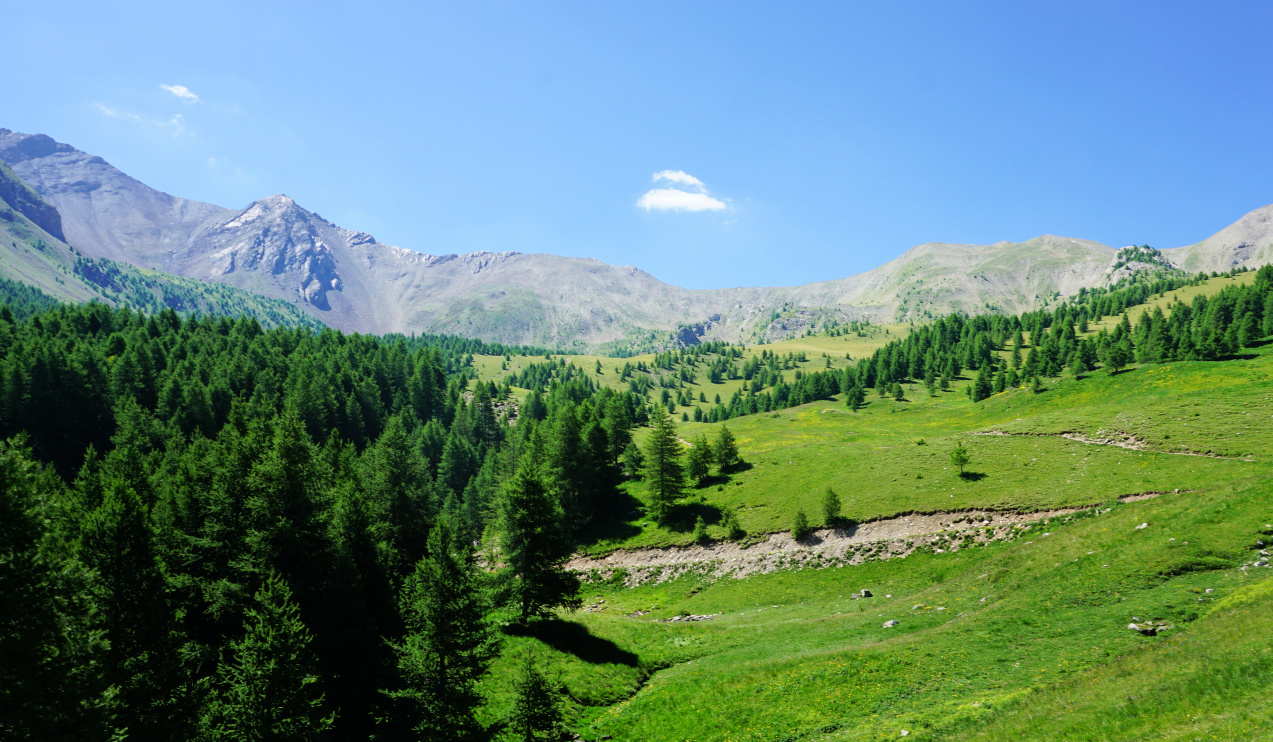 |
| Eissalete Valley Orres |
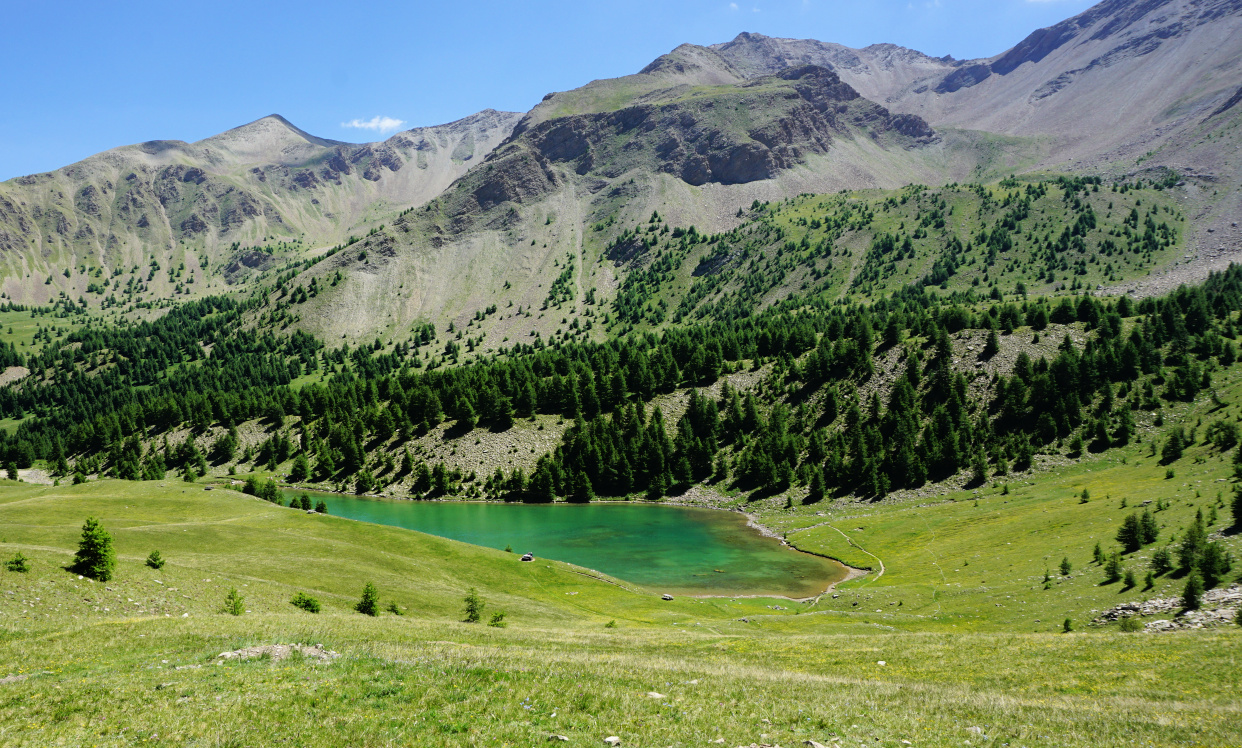 |
| Sainte-Marguerite Lake |
We used the familiar itinerary to the lake, starting from the parking at Bois Méan (~1650 m), just under the upper village. There’s a big signpost showing different itineraries. We headed south along a wide unpaved track, initially almost flat. We passed Bergerie Gautier. The track, still wide, became rockier. Now climbing steeper, we passed the crossroads to Source de Jerusalem and Col du Pouzenc. After Cabane du Lac, we left the forest behind us and entered the vast Alpine meadows in Vallon de l’Eissalete.
We soon reached the Ste-Marguerite Lake, and continued along its western shore. The trail to the mountain pass was marked with yellow and some cairns here and there. We soon met some curious marmots by the trail. The climb to the col was continuous (roughly one hour from the lake) but in no way difficult as marked in Les Orres guide.
 |
| Marmot by the trail |
 |
| Above Ste-Marguerite Lake |
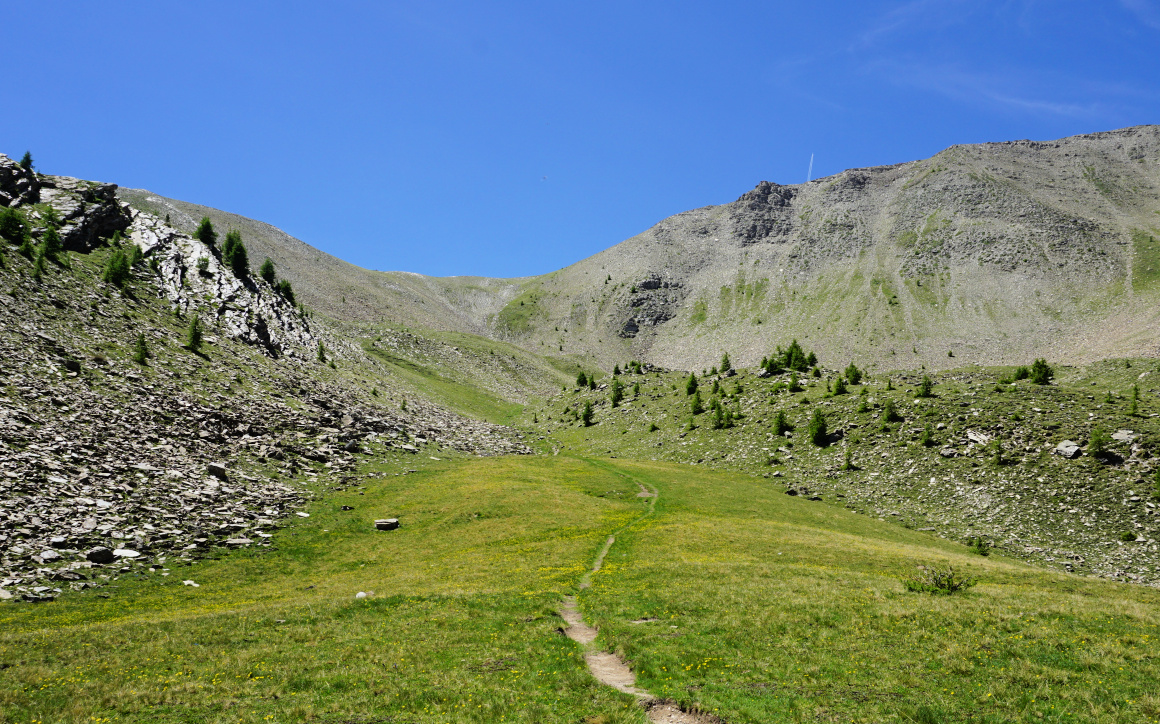 |
| Col de l'Ane in sight |
 |
| View southeast from Col de l'Ane |
 |
| Start of return trail to Les Orres |
 |
| Return trail to Les Orres |
The pass (also named Col de l’Eissalete) marked our turning point today. A “technical” ridge itinerary continued to the east to Aupillon (2916 m; the highest peak above Les Orres). We had great views down to the Ubaye River Valley and beyond as well as to the north Les Ecrins etc.
We descended to the lake, then forked right soon after, and followed the trail which went to Les Orres 1800. We crossed a small stream (a wooden bridge) and headed north. It was a most pleasant and soft path in the woods. In fact, nicer than the ascending trail! We stayed higher up fairly long before starting to descend to the resort. There were good signposts.
From Les Orres 1800, we descended along the road back to our starting point.
Map: 3438 ET Embrun Les Orres
 |
Quinoa-tomato bowl
|
Mozzarella balls are great added to warm roasted tomato wedges and cooked quinoa for a balanced protein- rich lunch. This dish is at its best in late summer and early autumn when tomatoes and basil are in season.
2 servings
100 ml quinoa mixture of white and red quinoa, mélange de quinoa blanc et rouge
2- 3 ripe tomatoes
2 tbsp. Olive oil
Freshly ground black pepper
1 clove garlic, minced
½ tsp. Dried Provençal herbs
150g mozzarella mini balls
A generous amount, about a handful, of basil leaves
Cook the quinoa in about 300 ml water for 15- 20 minutes. Remove from heat and keep covered for 5- 10 minutes.
Preheat the oven to 210°C, roast.
Wash the tomatoes and cut into wedges. Place the olive oil, garlic, Provençal herbs, and black pepper in a plastic bag. Add the tomato wedges and shake. Pour the wedges in an oven- proof dish and roast for about 15 minutes until the tomatoes are somewhat collapsed.
Meanwhile wash and dry the basil leaves and drain the mozzarella balls.
Fold in the tomatoes and mozzarella into the quinoa and divide into the bowls. Decorate with a generous amount of fresh basil.
The southern flank of the mountain massif above Embrun and the Durance River Valley consists of a wide forest belt reaching about 2000 m elevation. Higher up, the landscape becomes high-alpine.
Having previously hiked to Mont Guillaume (2542 m), we now decided to explore the trail up to the Hivernet Lake (2352 m), another popular itinerary in the region.
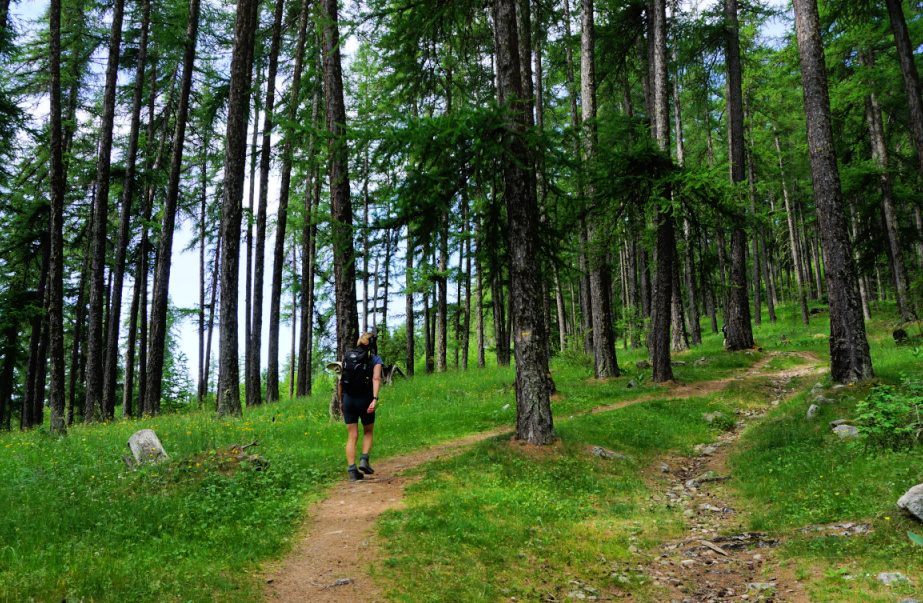 |
| Starting to Lake Hivernet |
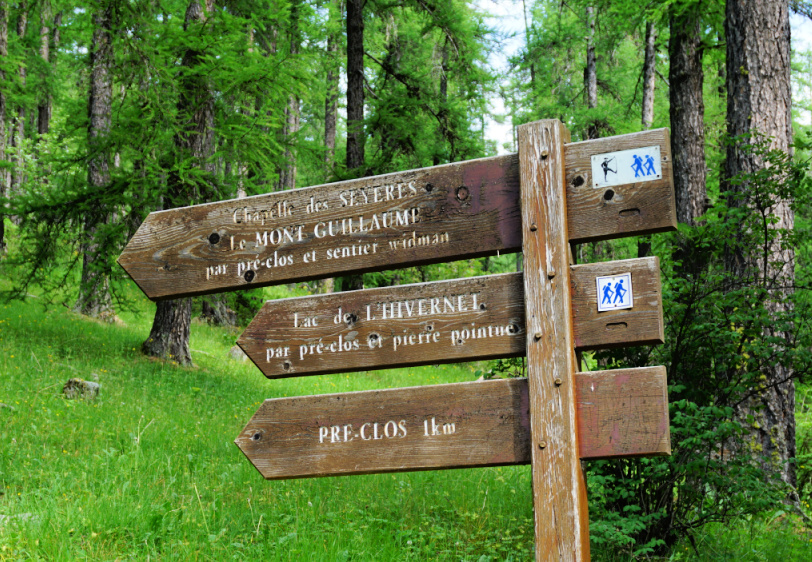 |
| Good signposts |
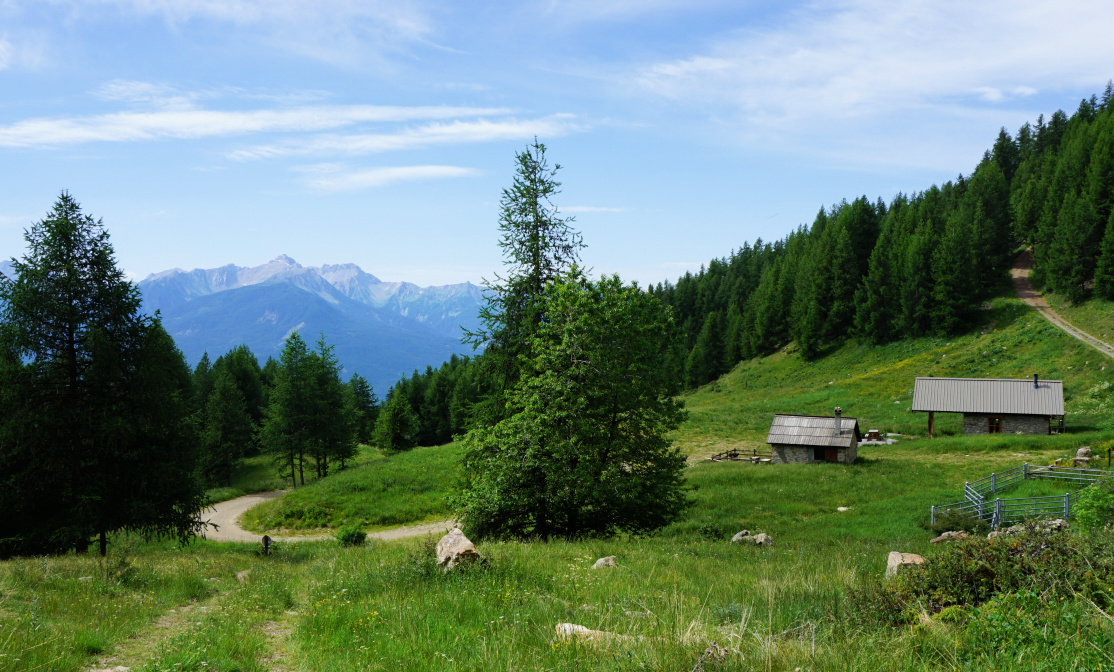 |
| Pré Clos |
 |
| Easy part of trail |
 |
Near Pierre Pointue
|
A paved albeit narrow and in places potholed road ascends to Parking de la Fôret (1587 m). There’s a network of paths and gravel tracks and the itinerary to Lake Hivernet (as well as to Mont Guillaume) is clearly signposted.
From the parking, we first ascended in the forest to Pré Clos. The larch forest gave good protection on a hot and sunny day during the first part of the ascent. The dirt track ended here. We continued straight north, still in the woods, passing Pierre Pointue. The path turned to the west, and we came to a clearing with a steeper incline in front of us. Now above the main tree line, we followed the trail, surrounded by blossoming rhododendrons up to the lake.
It was early season (mid-June), but the terrain was already snowless and dry. Fortunately, small streams from higher ground in the west were irrigating the beautiful Lac de l’Hivernet.
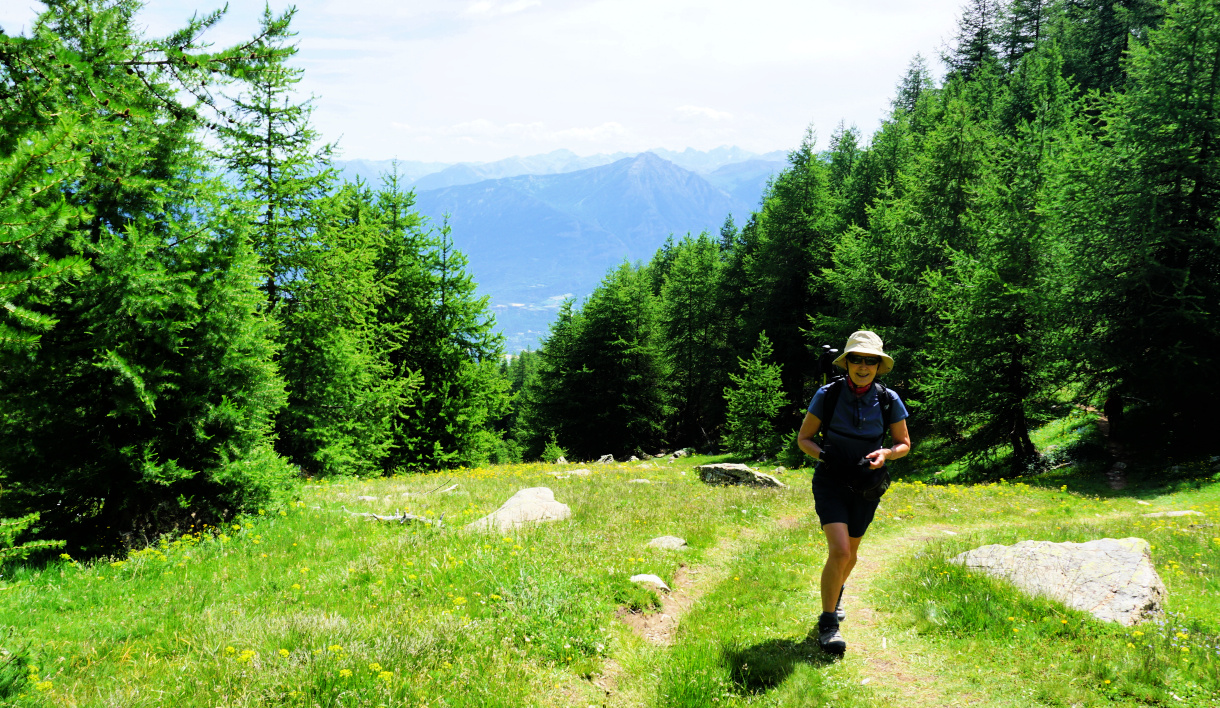 |
| At Tree line to Lake Hivernet |
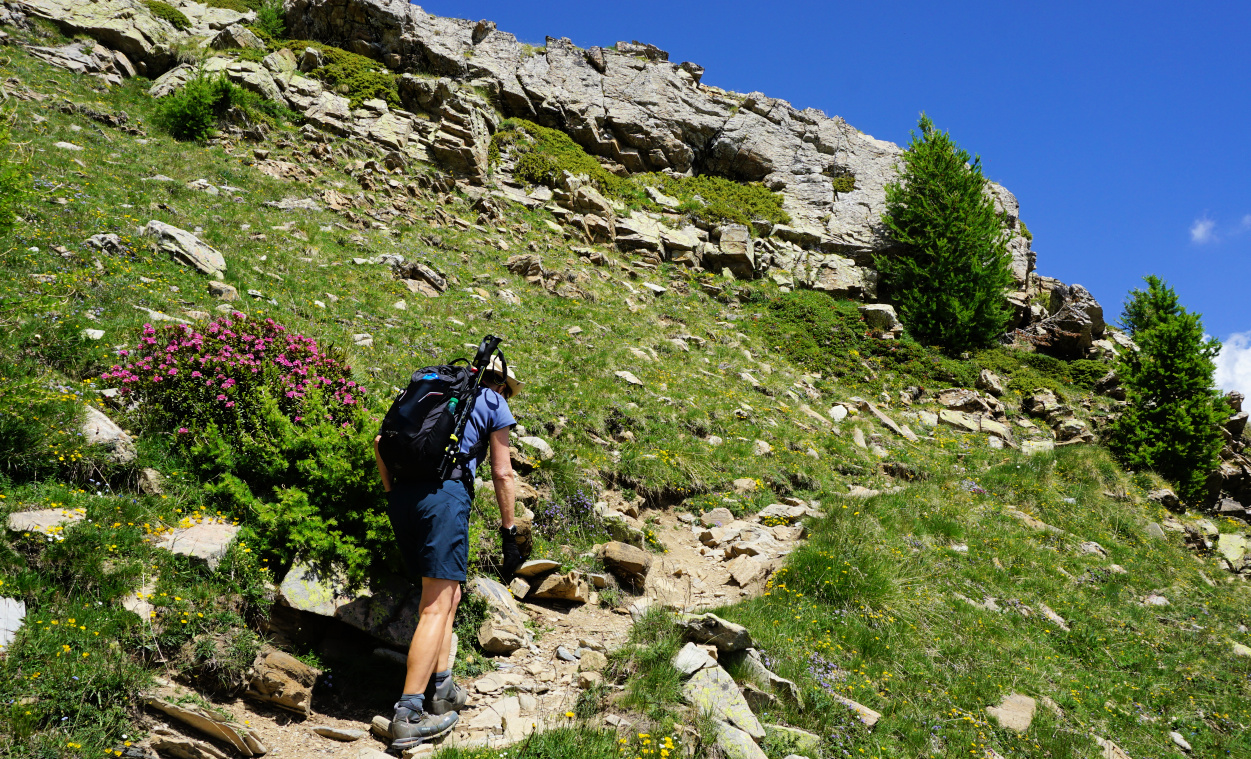 |
| Nearing Lake Hivernet |
 |
| Descent start from Lake Hivernet |
 |
| Durance River Valley |
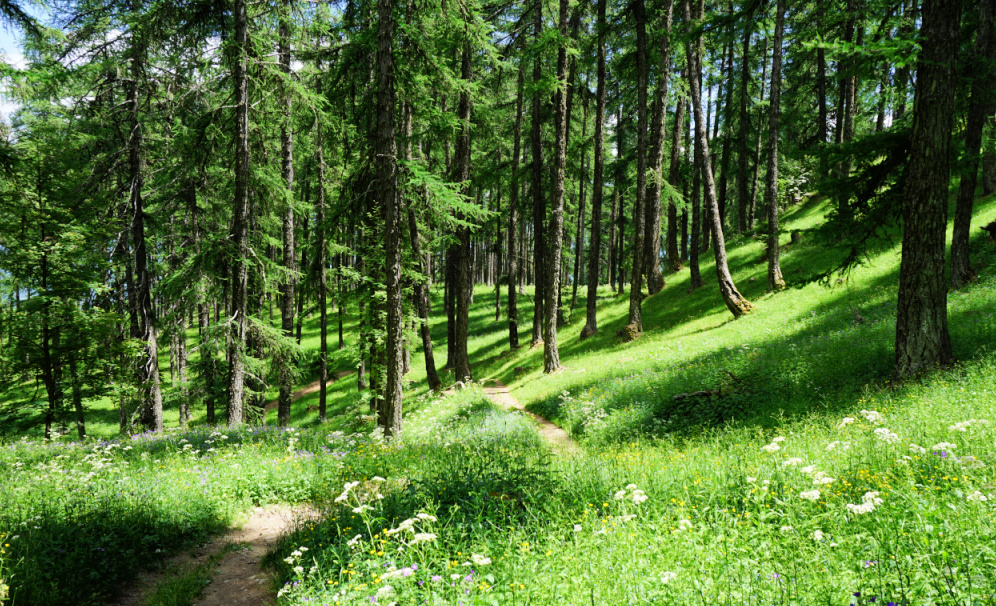 |
| Trail near Parking de la Fôret |
We returned along the same trail. It was not a long hike in distance but some stretches were rather steep, especially when approaching the lake.
Map: Orcières-Merlette 3437 ET
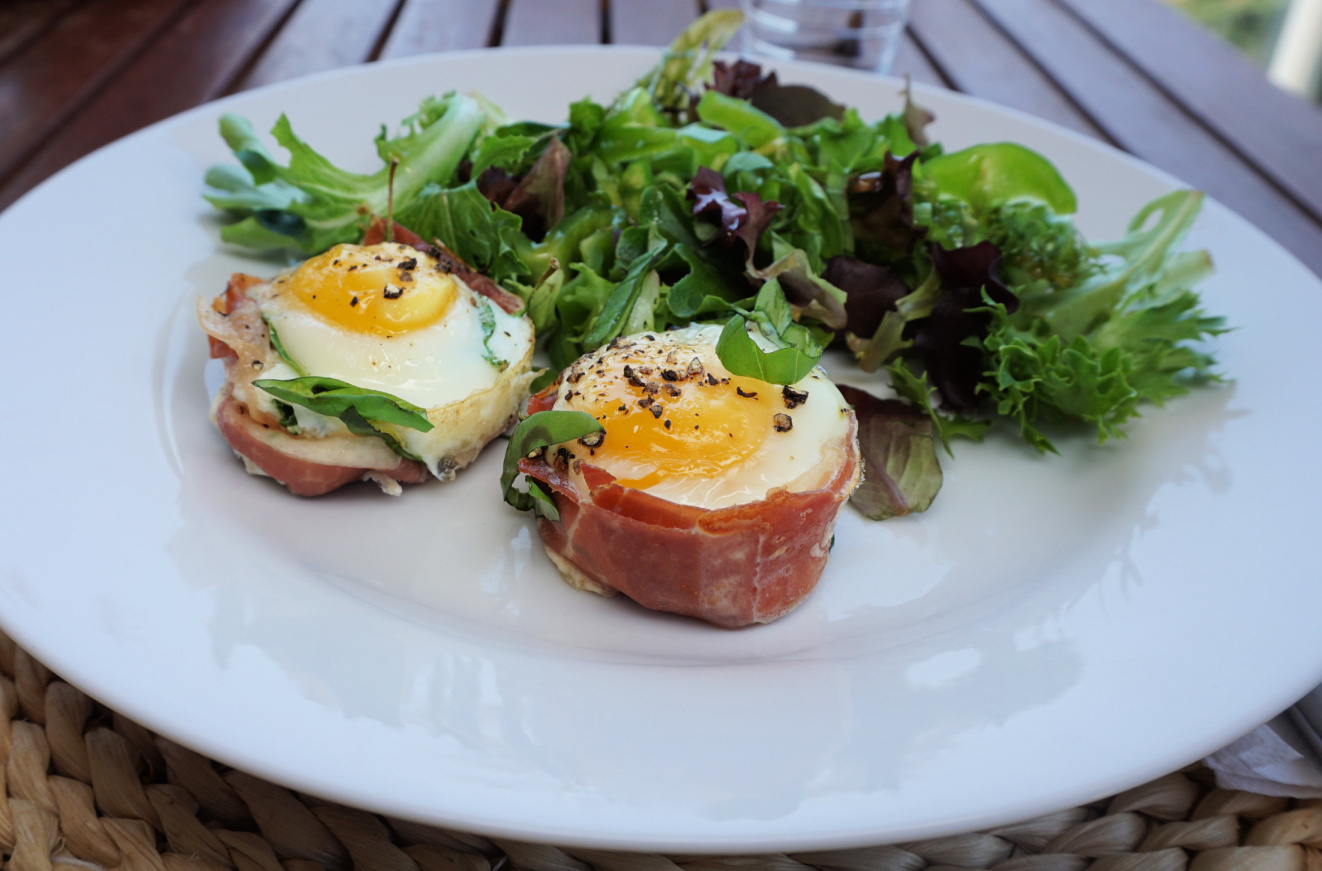 |
| Egg-Parma ham muffins |
These tasty small bakes make a nice light lunch served with a green side salad and whole wheat or rye bread.
2 servings
4 slices of Parma ham
4 eggs
Olive oil
A small handful of baby spinach leaves
Freshly ground black pepper
Fresh herbs to decorate
Preheat the oven to 180° C.
Oil 4 muffin tin cavities with olive oil. Line each cavity with a slice of Parma ham. Place some spinach leaves in the bottom. Crack 1 egg into each cavity and grind over some black pepper.
Bake for 10- 15 minutes until the egg whites are solidified. Sprinkle over some chopped fresh herbs.
 |
| Egg-Parma ham muffins from oven |
 |
Montagne de Thiey in autumn
|
We have previously made this great hike to Montagne de Thiey (1553 m) in the Côte d’Azur Prealps some years ago in early autumn. Now, in spring, the scenery could not be more different, with the nascent greenery of the various vegetation zones. Near the summit, we saw wild peonies and, when returning, we walked through a beautiful beech forest.
 |
| Start from Nans parking |
 |
| Forest above Nans Valley |
 |
| Southern flank of Montagne de Thiey |
The access from the coast is easy as the parking by the Nans Valley is next to the RD85 road (19 km from Grasse).
The itinerary from the parking (860 m) was easy to follow as the signposts and markings (yellow) were numerous. We ascended both along dirt tracks and good trails (signposts #65, 66, 67, 68, 69, 70 and 71). There were some steeper stretches just before the summit. Even on a hazy albeit clear day we had great 360° views, from the snow-capped Mercantour peaks to the Esterel coastal mountains.
We returned to signpost #69, then headed northeast under Crête de Thiey. We descended, quite steeply in places, to a beech forest at about 1000 m elevation where we forked right at signpost #178. After a brief ascent we descended continuously to the verdant Nans Valley, passing signposts #72 and 127. The stream in the valley was completely dry. There had been only sporadic rainy days since the beginning of the year. We passed signpost #66 before reaching our starting point.
Most hikers seemed to return along the same trail. We warmly recommend the loop on the way back.
 |
| Nans Valley and Colle du Maçon |
 |
| Signpost#69 return trail crossroads |
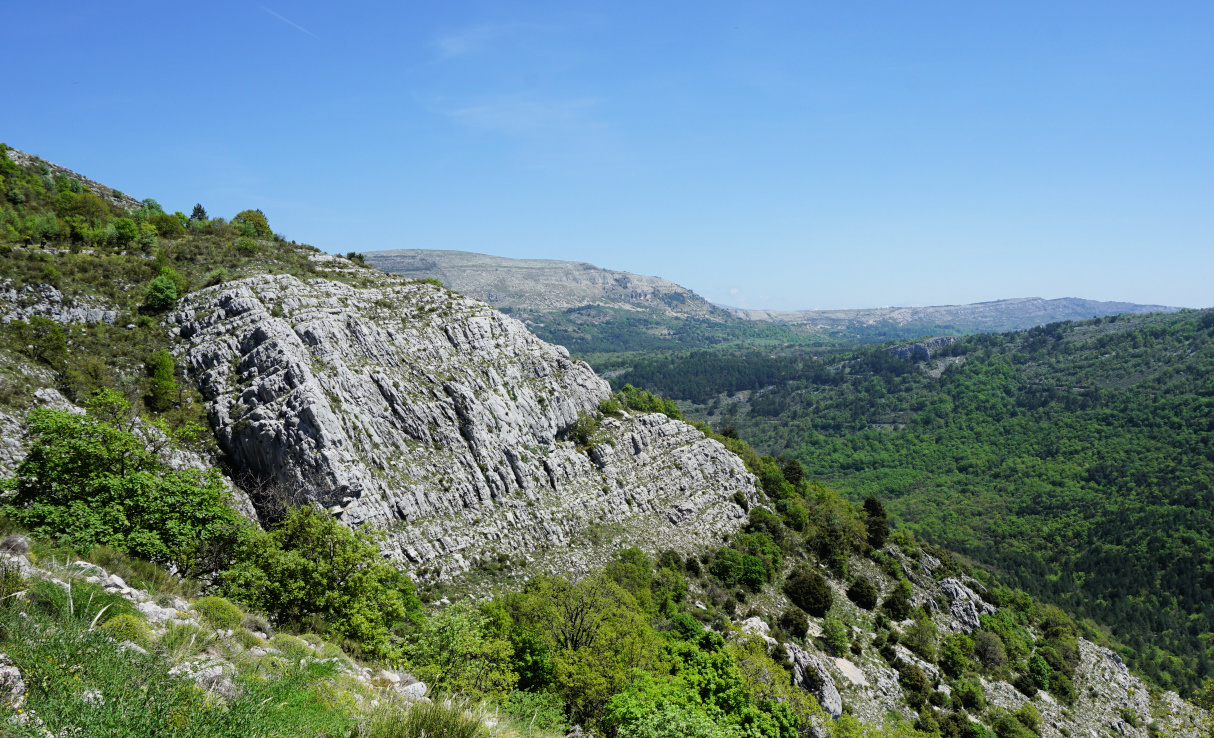 |
| Barres de Thiey |
 |
| Near Montagne de Thiey summit |
 |
| Montagne de Thiey summit |
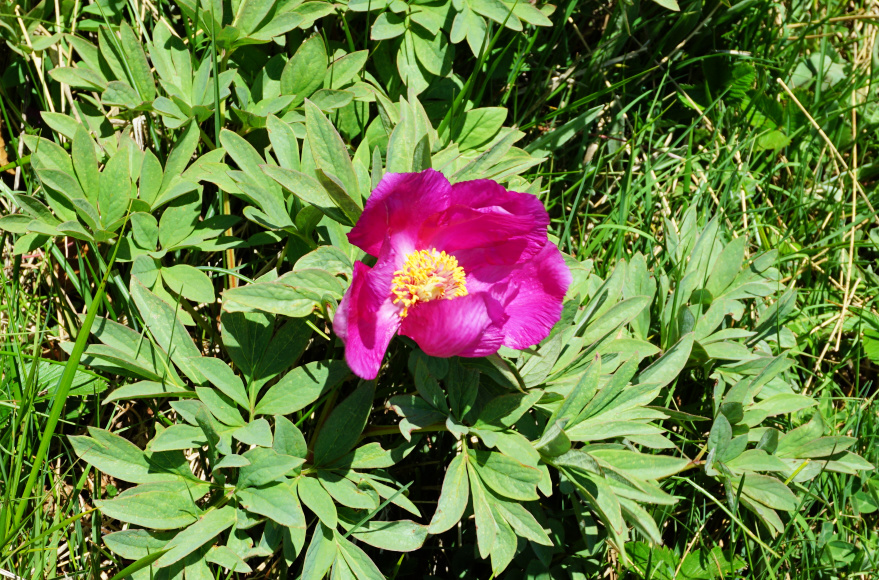 |
| Wild peony by the trail |
 |
| Crete de Thiey southeastern flank |
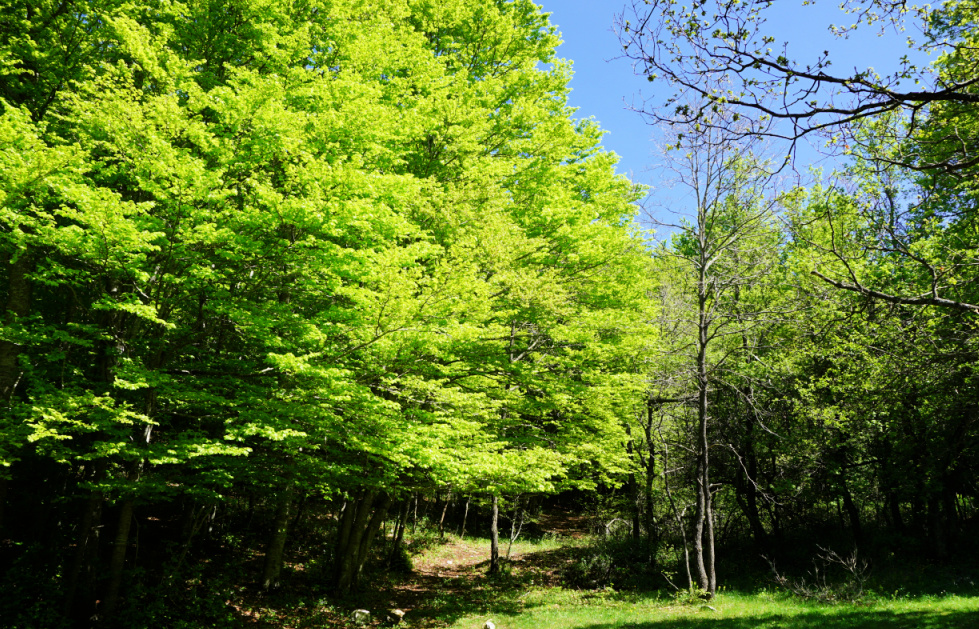 |
| Beech forest by the trail back |
Map: “Haute Signe” 3543 ET
 |
| Veal escalopes stuffed with Parma ham |
This classic Italian dish gets a different twist if you use basil leaves instead of sage leaves and add some good tomato sauce to the white wine sauce. Whole wheat pasta with parmesan and steamed green beans go well with the veal.
2 servings
2 thin veal escalopes, about 120- 150 g each
2 slices of Parma ham
4 basil leaves
2 tbsp. olive oil
Some wheat flour for dusting
150 ml white wine
2 tbsp. tomato sauce
Freshly ground black pepper
Place the escalopes between two sheets of aluminium foil and pound with your fist to make them thinner. Grind over some black pepper and place a slice of Parma ham on each escalope, followed by basil leaves. Fold over the escalopes to make a pocket and secure with a cocktail stick. Lightly dust both sides of the escalopes with flour.
Warm 2 tbsp. olive oil over medium- high heat in a frying pan. Cook the escalopes 2- 3 minutes on both sides until golden brown. Add the wine, tomato sauce, and some more black pepper. Increase the heat to high and let bubble until reduced by about half.
Drain the cooked pasta, divide on the plates and fold in some parmesan. Divide the escalopes surrounded with the sauce and steamed green beans on the plates.
 |
| Beachfront near Trayas station |
The Esterel Coastal Massif located both in Var and Alpes Maritimes Departments is of volcanic origin. The rock consists mostly of rhyolite, giving the hills a distinct red colour.
Numerous roads, some of them paved, crisscross the region. But there is a network of hiking and mountain biking trails as well, and some of them cross surprisingly rugged and sauvage terrain. The landscape is quite different from what you see elsewhere in Alpes-Maritimes.
We decided to hike up to Pic de l’Ours (496 m), starting from the parking by the D559 coastal road, near the Trayas train station. Another option is to use the small parking next to the station.
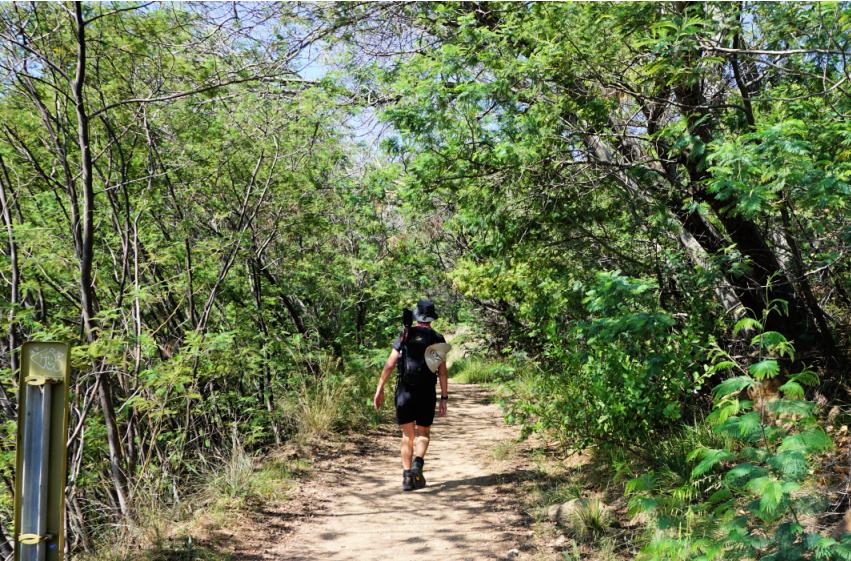 |
| Trail behind Trayas station |
 |
| Rocky trail above Le Trayas |
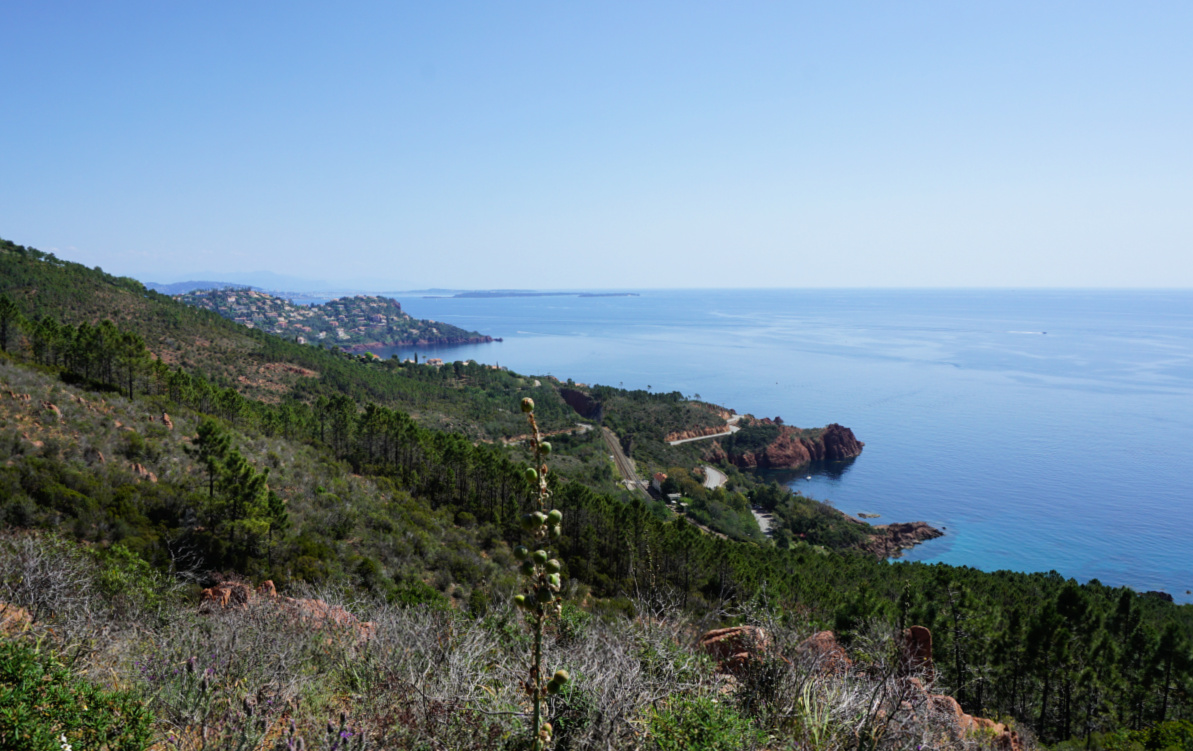 |
| Le Trayas coast |
 |
| Pic de l'Ours |
We walked up to the starting point behind the station (300 m), carefully crossing the road and the railway. We forked left and followed a wide dirt track about 370 m, then forked right and ascended along a rocky trail about 400 m before reaching a crossroads. We forked sharply right (if you miss this, you end up doing the hike clockwise!) now along a yellow-marked trail. We climbed, partly in the woods, to Col de Notre-Dame (324 m).
We now had Pic de l’Ours above us, and chose the direct route up to the summit. The trail (blue markings) was quite steep in places. The summit itself was a restricted area, with a large white/red mast and different other telecom antennas. The spring day was warm but a bit hazy. We had nevertheless great views towards Cannes and beyond in the east and Frejus in the west.
 |
| Cannes seen from Pic de l'Ours |
 |
| Dent de l'Ours |
 |
| Pic du Cap Roux |
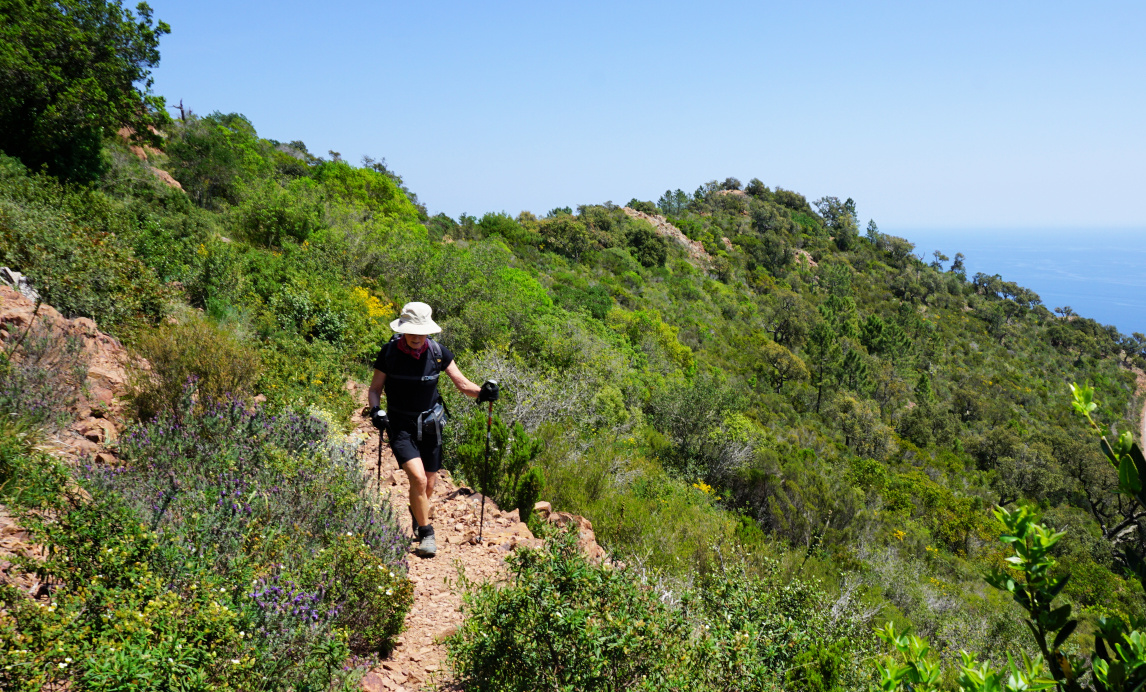 |
| Path under Pic de l'Ours summit |
After a picnic break, we continued along a yellow-marked trail which first circled under the summit then descended rapidly to Dent de l’Ours. Our trail continued to the south, then west making a large loop in the rugged terrain before turning southeast to Col de Lentisques. We then followed the yellow trail which descended above Ravine de Cazal de Beuf, where we passed the crossroads on the way up, then back to or starting point.
The trails of this hike were good but very rocky. Good hiking shoes and poles are essential. It can be very hot during the summer months. Compared with Alpes-Maritimes, there are just sporadic signposts but the itinerary is well colour-marked and easy to follow. Study the itinerary on the map (digital or paper) before leaving.
Duration: about 3h 45 active
Map: 3544ET Fréjus St-Raphaël Corniche de l’Esterel
Spinach is a popular vegetable in all Mediterranean countries. I remember a trip to Rome one autumn when almost all small restaurants served only boiled spinach as a vegetable side.
Spinach is said to have originated somewhere in Persia, and was brought into the Mediterranean countries by the Arabs. The following recipe with pine nuts and golden raisins suggests an Arab origin. This vegetable side goes very well with roasted mackerel fillets and panisses, South of France chick pea cakes.
2 servings
About 4 handfuls of baby salad leaves
2 tbsp. golden raisins
2 tbsp. pine nuts
1 tbsp. olive oil
2 shallots, chopped
1 clove garlic, minced
Freshly ground black pepper
Warm the olive oil in a large saucepan over medium- low heat and start sautéing the golden raisins and pine nuts. Add the shallots and garlic and continue sautéing for 10 minutes until soft.
Wash and dry the spinach leaves and add to the saucepan. Raise the heat to medium and sauté for about 5- 10 minutes until the spinach is wilted.
Serve with roasted mackerel fillets and panisses.
Today’s hike features a loop above Vence, starting from the popular Plan des Noves parking (780 m) by the D2 road. Having hiked here many times, we now wanted to try a new itinerary, first using tracks and trails west of the D2 road.
 |
| Track leaving GR51 |
 |
| Mouton d'Anou |
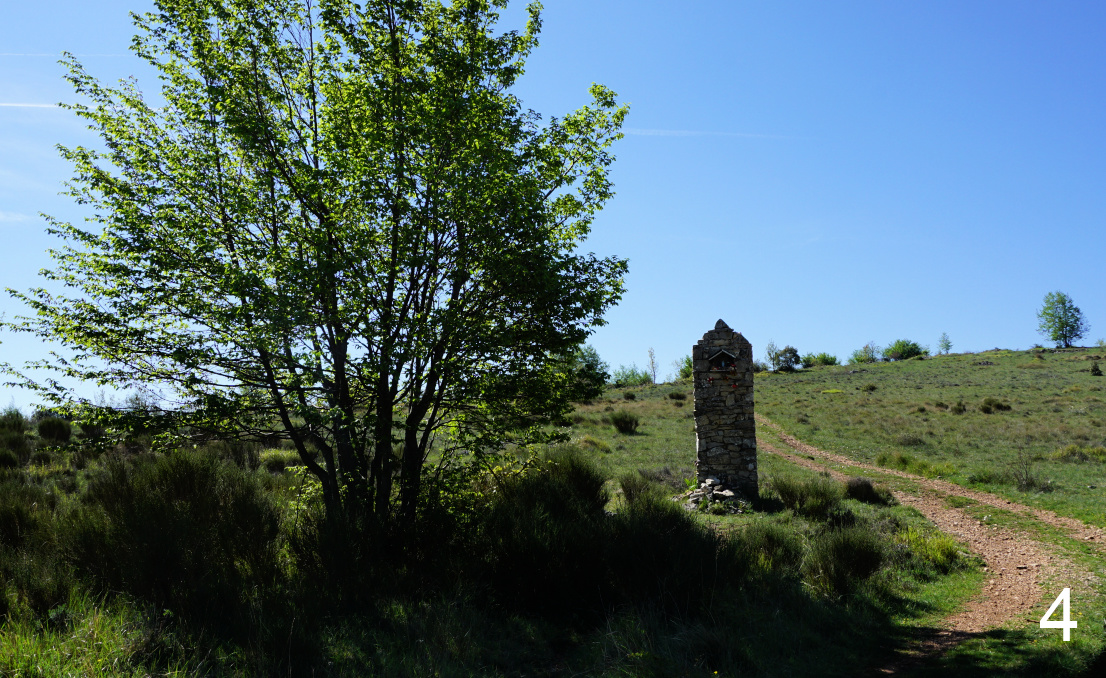 |
| Oratory |
 |
| Puy de Naouri and Tourrettes |
We crossed the road and headed west along the GR51 (images 1 and 3 ) as far as to signpost #136 where we forked left (2 ), leaving the GR trail (and marked hiking trails). We followed a wide track mainly to the south, passing an oratory (4 ). We made a short detour to a hilltop (839 m) at Jas de Bayle with great views to the west, notably to Puy de Naouri and Puy de Tourrettes (5 ). We continued along the dirt track (no markings but easy to follow) further south, then to the east (6 ). Near Colle Bertrand we forked left (7 ) and followed a narrower trail which passed a solitary oak tree, then descended in a northerly direction towards the D2 road.
We soon reached the road, forked right and descended along it (carefully in a single line) about 500 m to signpost #130 (581 m), where we followed the trail up to Mangia Pan (699 m; signpost #131; image 8 ).
We headed straight north to signpost #133 (at 678 m; marked as Plan des Noves) where we re-joined the GR51 trail and followed it back to our starting point.
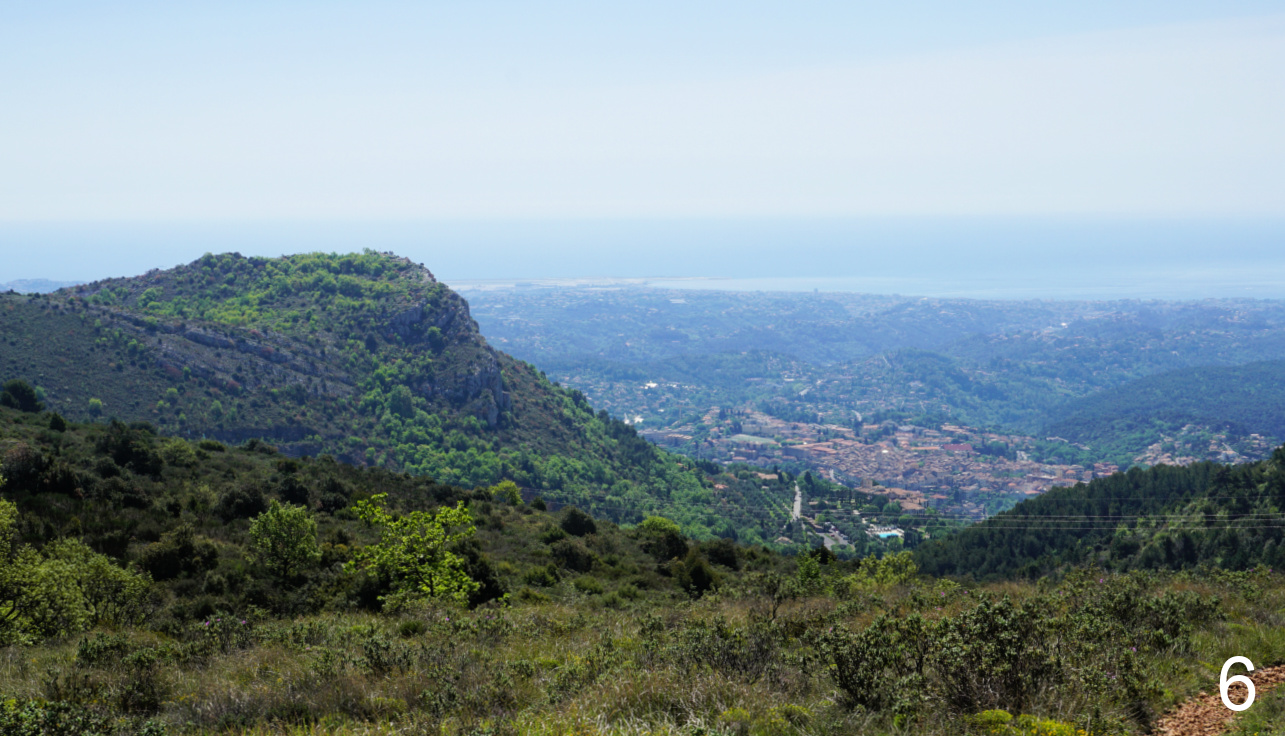 |
| Baou des Blancs and Vence |
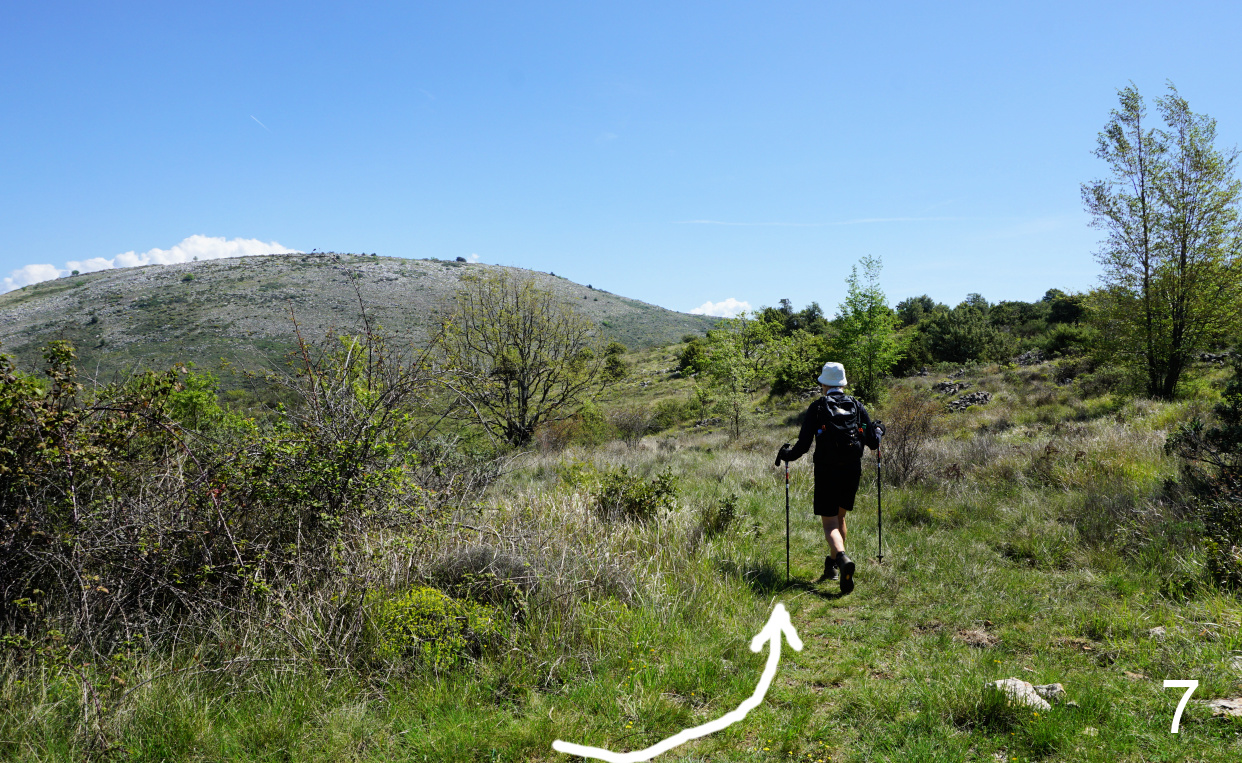 |
| Crossroads near Colle Bertrand |
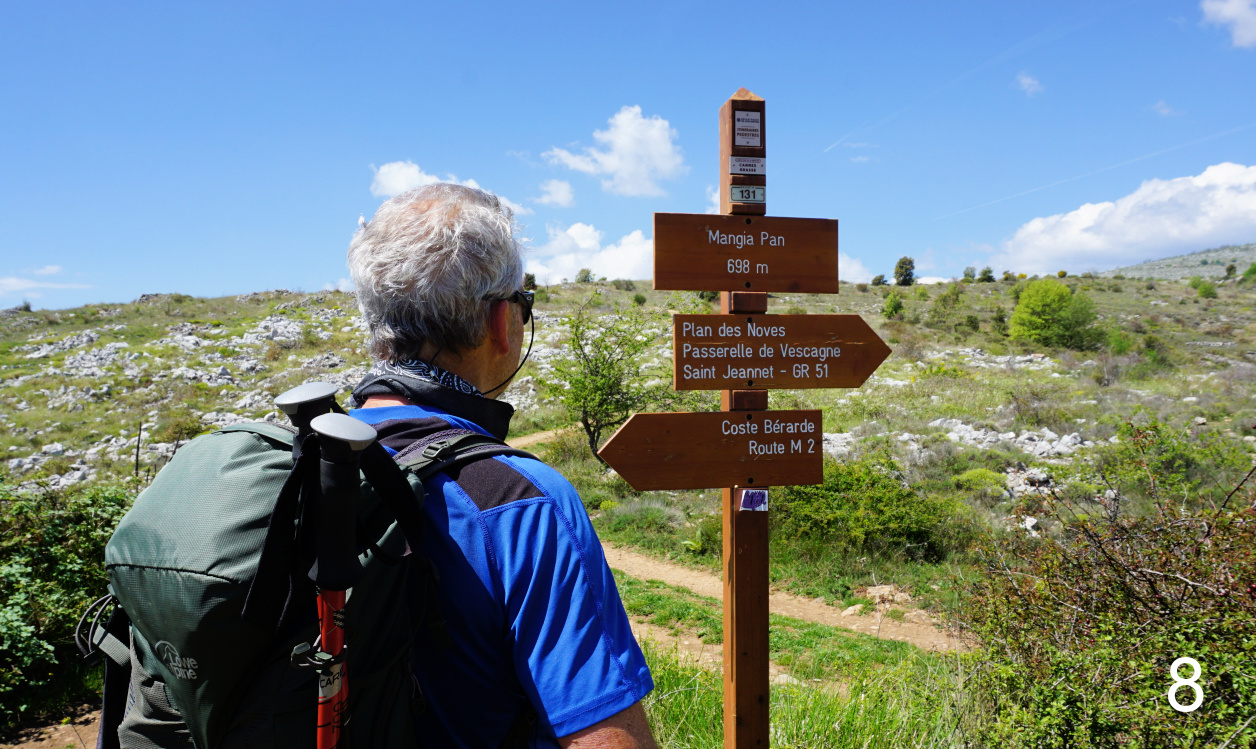 |
| Mangia Pan |
It turned out to be a nice loop variant along easy trails. Only the trail descending back to the RD2 road was narrow in places and might become a bit overgrown in summer.
Map: «Cannes-Grasse» Côte d’Azur No 3643 ET or Vallée de l’Estéron Vallée du Loup 3642 ET
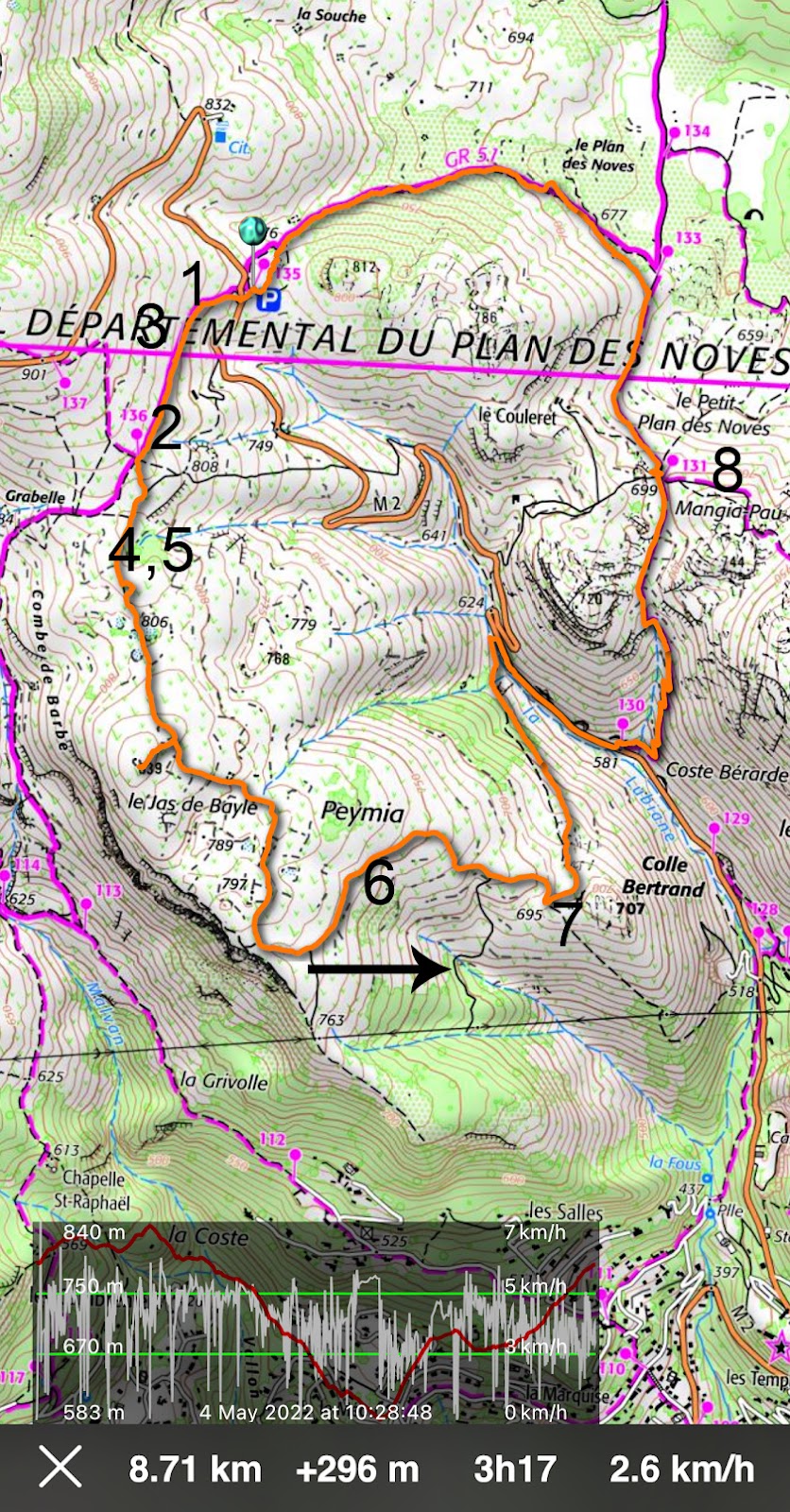 |
| Loop from Plan des Noves parking |













